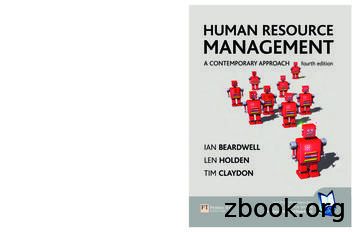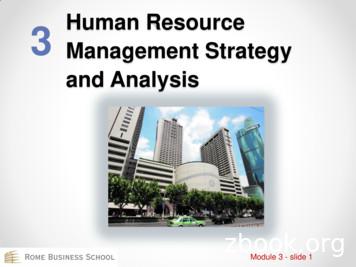Strategic Human Resource Management - Otaru University Of .
Chapter twoStrategic humanresource managementJohn BrattonStrategic human resource management is the process of linkingthe human resource function with the strategic objectives of theorganization in order to improve performance.‘If a global company is to function successfully, strategies at different levels need to inter-relate.’ 1‘An organization’s [human resource management] policies and practices must fit with its strategyin its competitive environment and with the immediate business conditions that it faces.’ 2‘The [human resources–business strategy] alignment cannot necessarily becharacterized in the logical and sequential way suggested by some writers; rather,the design of an HR system is a complex and iterative process.’ 3Chapter outlineIntroduction p.38Strategic management p.38Strategic human resourcemanagement p.45Human resource strategy models p.49Evaluating strategic human resourcemanagement and models of humanresources strategy p.56Dimensions of strategic humanresource management p.59International and comparativestrategic human resourcemanagement p.61Chapter objectivesAfter studying this chapter, you should be able to:1. Explain the meaning of strategic management and give an overview of its conceptualframework2. Describe the three levels of strategy formulation and comment on the links betweenbusiness strategy and human resource management (HRM)3. Explain three models of human resources (HR) strategy: control, resource and integrative4. Comment on the various strategic HRM themes of the HR–performance link:re-engineering, leadership, work-based learning and trade unions5. Outline some key aspects of international and comparative HRM
38Human Resource ManagementIntroductionIn the first chapter, we examined the theoretical debate on the nature and significanceof the human resource management (HRM) model; in this chapter we explore anapproach to HRM labelled strategic human resource management, or SHRM. By astrategic approach to HRM, we are referring to a managerial process requiring humanresource (HR) policies and practices to be linked with the strategic objectives of theorganization. Just as the term ‘human resource management’ has been contested, sotoo has the notion of SHRM. One aspect for debate is the lack of conceptual clarity(Bamberger & Meshoulam, 2000). Do, for example, the related concepts of SHRM andHR strategy relate to a process or an outcome?Over the past decade, HR researchers and practitioners have focused their attentionon other important questions. First, what determines whether an organization adoptsa strategic approach to HRM, and how is HR strategy formulated? Of interest is whichorganizations are most likely to adopt a strategic approach to HRM. Is there, forexample, a positive association with a given set of external and internal characteristicsor contingencies and the adoption of SHRM? Another area of interest concerns thepolicies and practices making up different HR strategies. Is it possible to identify acluster or ‘bundle’ of HR practices with different strategic competitive models? Finally,much research productivity in recent years has been devoted to examining the relationship between different clusters of HR practices and organizational performance.Does HR strategy really matter? For organizational practitioners who are looking forways to gain a competitive advantage, the implication of HR strategic choices forcompany performance is certainly the key factor.Before, however, we look at some of the issues associated with the SHRM debate, weneed first to examine the strategic management process. This chapter also examineswhether it is possible to speak of different ‘models’ of HR strategy and the degree towhich these types of HR strategy systematically vary between organizations. We thenconsider some issues associated with SHRM, including international and comparativeSHRM. As for the question of whether there is a positive association between differentHR strategies and organizational performance, we are of the opinion that, given theimportance and volume of the research surrounding this issue, the topic warrants anextended discussion (Chapter 13). In the current chapter, we address a number ofquestions, some essential to our understanding of how work organizations operate inthe early 21st century work and the role of HRM therein. How do ‘big’ corporate decisions impact on HRM? Does the evidence suggest that firms adopting differentcompetitive strategies adopt different HR strategies? How does HRM impact on the‘bottom line’? There is a common theme running through this chapter, much of theHR research pointing out that there are fundamental structural constraints that attestto the complexity of implementing different HRM models.Strategic managementThe word ‘strategy’, deriving from the Greek noun strategus, meaning ‘commander inchief’, was first used in the English language in 1656. The development and usage ofthe word suggests that it is composed of stratos (army) and agein (to lead). In amanagement context, the word ‘strategy’ has now replaced the more traditionalterm – ‘long-term planning’ – to denote a specific pattern of decisions and actions
Strategic Human Resource Management39Senior managementEnvironmentResourcesFigure 2.1 The three traditional poles of a strategic planSource: Adapted from Aktouf (1996)undertaken by the upper echelon of the organization in order to accomplish performance goals. Wheelen and Hunger (1995, p. 3) define strategic management as ‘that setof managerial decisions and actions that determines the long-run performance of acorporation’. Hill and Jones (2001, p. 4) take a similar view when they define strategyas ‘an action a company takes to attain superior performance’. Strategic managementis considered to be a continuous activity that requires a constant adjustment of threemajor interdependent poles: the values of senior management, the environment, andthe resources available (Figure 2.1).HRM IN PRACTICE 2.1STRATEGY PLANNING HAS SUDDENLY GOT SEXYGORDON PITT. THE INS AND OUTS OF MANAGEMENT TOOLS. GLOBE AND MAIL, 1998, JANUARY 8In the past decade, the NorthAmerican workplace, as thosein Europe, has seen a constantparade of management fadsand fashions. In 1993, the topthree most popular management techniques were missionstatements, customer satisfaction measurement, and totalquality management. In 1996,strategic planning, missionstatements and benchmarkingwere the top three managementtechniques. Of the 409 NorthAmerican companies surveyed,89 per cent reported using strategic planning in 1996. As onebusiness observer (Pitt, 1998)commented: ‘Strategic planninghas always been around [but] itsuddenly got sexy.’Model of strategic managementIn the descriptive and prescriptive management texts, strategic management appearsas a cycle in which several activities follow and feed upon one another. The strategicmanagement process is typically broken down into five steps:
40Human Resource Management1.2.3.4.5.mission and goalsenvironmental analysisstrategic formulationstrategy implementationstrategy evaluation.Figure 2.2 illustrates how the five steps interact. At the corporate level, the strategicmanagement process includes activities that range from appraising the organization’scurrent mission and goals to strategic evaluation.The first step in the strategic management model begins with senior managers evaluating their position in relation to the organization’s current mission and goals. Themission describes the organization’s values and aspirations; it is the organization’sraison d’être and indicates the direction in which senior management is going. Goalsare the desired ends sought through the actual operating procedures of the organization and typically describe short-term measurable outcomes (Daft, 2001).Environmental analysis looks at the internal organizational strengths and weak-STEP 1Mission and goalsManagement philosophyValuesSTEP 2Environmental analysisInternal scanExternal scanSTEP 3Strategic formulationStrategic choiceCorporateBusinessFunctionalSTEP 4Strategy implementationLeadershipStructureControl systemsHuman resourcesSTEP 5Strategy evaluationOperating performanceFinancial performanceFigure 2.2 The strategic management model
Strategic Human Resource Management41nesses and the external environment for opportunities and threats. The factors thatare most important to the organization’s future are referred to as strategic factors andcan be summarized by the acronym SWOT – Strengths, Weaknesses, Opportunitiesand Threats.Strategic formulation involves senior managers evaluating the interaction betweenstrategic factors and making strategic choices that guide managers to meet the organization’s goals. Some strategies are formulated at the corporate, business and specificfunctional levels. The term ‘strategic choice’ raises the question of who makes decisions and why they are made (McLoughlin & Clark, 1988). The notion of strategicchoice also draws attention to strategic management as a ‘political process’ wherebydecisions and actions on issues are taken by a ‘power-dominant’ group of managerswithin the organization. Child (1972, quoted in McLoughlin & Clark, 1988, p. 41)affirms this interpretation of the decision-making process when he writes:[W]hen incorporating strategic choice in a theory of organizations, one is recognizing theoperation of an essentially political process, in which constraints and opportunities arefunctions of the power exercised by decision-makers in the light of ideological values.In a political model of strategic management, it is necessary to consider the distribution of power within the organization. According to Purcell and Ahlstrand (1994,p. 45), we must consider ‘where power lies, how it comes to be there, and how theoutcome of competing power plays and coalitions within senior managementare linked to employee relations’. The strategic choice perspective on organizationaldecision-making makes the discourse on strategy ‘more concrete’ and provides important insights into how the employment relationship is managed.Strategy implementation is an area of activity that focuses on the techniques used bymanagers to implement their strategies. In particular, it refers to activities that dealwith leadership style, the structure of the organization, the information and controlsystems, and the management of human resources (see Figure 1.2 above). Influentialmanagement consultants and academics (for example Champy, 1996; Kotter, 1996)emphasize that leadership is the most important and difficult part of the strategicimplementation process.Strategy evaluation is an activity that determines to what extent the actual changeand performance match the desired change and performance.The strategic management model depicts the five major activities as forming arational and linear process. It is, however, important to note that it is a normativemodel, that is, it shows how strategic management should be done rather thandescribing what is actually done by senior managers (Wheelen & Hunger, 1995). As wehave already noted, the notion that strategic decision-making is a political processimplies a potential gap between the theoretical model and reality.Hierarchy of strategyAnother aspect of strategic management in the multidivisional business organizationconcerns the level to which strategic issues apply. Conventional wisdom identifiesdifferent levels of strategy – a hierarchy of strategy (Figure 2.3):1. corporate2. business3. functional.
42Human Resource ManagementContextualfactorsCorporate-level strategyProduct marketCorporate managementWhat business are we in?Capital marketLabour marketBusinessunit 1TechnologyBusinessunit 2Businessunit 3Business-level strategyHow do we compete?GovernmentpoliciesEuropean UnionpoliciesNorth AmericanFree TradeAgreementpoliciesR&D MarketingManuHumanFinanceresources facturingFunctional-levelstrategyHow do we supportthe business-levelcompetitive strategy?StakeholderinterestsHuman resource management: philosophy, policies,programmes, practices, processes, relationships with managers,non-managers, trade unions, customers and suppliersFigure 2.3 Hierarchy of strategic decision makingCorporate-level strategyCorporate-level strategy describes a corporation’s overall direction in terms of itsgeneral philosophy towards the growth and the management of its various businessunits. Such strategies determine the types of business a corporation wants to beinvolved in and what business units should be acquired, modified or sold. Thisstrategy addresses the question, ‘What business are we in?’ Devising a strategy for amultidivisional company involves at least four types of initiative:establishing investment priorities and steering corporate resources into the mostattractive business units
Strategic Human Resource Management43initiating actions to improve the combined performance of those business unitswith which the corporation first became involvedfinding ways to improve the synergy between related business units in order toincrease performancemaking decisions dealing with diversification.Business-level strategyBusiness-level strategy deals with decisions and actions pertaining to each businessunit, the main objective of a business-level strategy being to make the unit morecompetitive in its marketplace. This level of strategy addresses the question, ‘How dowe compete?’ Although business-level strategy is guided by ‘upstream’, corporate-levelstrategy, business unit management must craft a strategy that is appropriate for itsown operating situation. In the 1980s, Porter (1980, 1985) made a significant contribution to our understanding of business strategy by formulating a framework thatdescribed three competitive strategies: cost leadership, differentiation and focus.The low-cost leadership strategy attempts to increase the organization’s marketshare by having the lowest unit cost and price compared with competitors. Thesimple alternative to cost leadership is differentiation strategy. This assumes thatmanagers distinguish their services and products from those of their competitors inthe same industry by providing distinctive levels of service, product or high qualitysuch that the customer is prepared to pay a premium price. With the focus strategy,managers focus on a specific buyer group or regional market. A market strategy canbe narrow or broad, as in the notion of niche markets being very narrow or focused.This allows the firm to choose from four generic business-level strategies – low-costleadership, differentiation, focused differentiation and focused low-cost leadership –in order to establish and exploit a competitive advantage within a particular competitive scope (Figure 2.4).COMPETITIVE ADVANTAGECOMPETITIVE SCOPELow costBroadtargetNarrowtargetUniquenessLow-cost leadershipDifferentiatione.g. Wal-Marte.g. Tommy Hilfiger’s apparelFocused low-costleadershipFocused differentiatione.g. Rent-A-Wreck CarsFigure 2.4 Porter’s competitive strategiesSource: Adapted from Porter (1985)e.g. Mountain EquipmentCo-operative
44Human Resource ManagementMiles and Snow (1984) have identified four modes of strategic orientation:defenders, prospectors, analysers and reactors. Defenders are companies with a limitedproduct line and a management focus on improving the efficiency of their existingoperations. Commitment to this cost orientation makes senior managers unlikely toexplore new areas. Prospectors are companies with fairly broad product lines that focuson product innovation and market opportunities. This sales orientation makes seniormanagers emphasize ‘creativity over efficiency’. Analysers are companies that operatein at least two different product market areas, one stable and one variable. In this situation, senior managers emphasize efficiency in the stable areas and innovation in thevariable areas. Reactors are companies that lack a consistent strategy–structure–culturerelationship. In this reactive orientation, senior management’s responses to environmental changes and pressures thus tend to be piecemeal strategic adjustments.Competing companies within a single industry can choose any one of these four typesof strategy and adopt a corresponding combination of structure, culture and processesconsistent with that strategy in response to the environment. The different competitive strategies influence the ‘downstream’ functional strategies.Functional-level strategyFunctional-level strategy pertains to the major functional operations within the business unit, including research and development, marketing, manufacturing, financeand HR. This strategy level is typically primarily concerned with maximizing resourceproductivity and addresses the question, ‘How do we support the business-levelcompetitive strategy?’ Consistent with this, at the functional level, HRM policies andpractices support the business strategy goals.These three levels of strategy – corporate, business and functional – form a hierarchyof strategy within large multidivisional corporations. In different corporations, thespecific operation of the hierarchy of strategy might vary between ‘top-down’ and‘bottom-up’ strategic planning. The top-down approach resembles a ‘cascade’ inwhich the ‘downstream’ strategic decisions are dependent on higher ‘upstream’strategic decisions (Wheelen & Hunger, 1995). The bottom-up approach to strategymaking recognizes that individuals ‘deep’ within the organization might contribute tostrategic planning. Mintzberg (1978) has incorporated this idea into a model of ‘emergent strategies’, which are unplanned responses to unforeseen circumstances by nonexecutive employees within the organization. Strategic management literatureemphasizes that the strategies at different levels must be fully integrated. Thus:strategies at different levels need to inter-relate. The strategy at corporate level mustbuild upon the strategies at the lower levels in the hierarchy. However, at the sametime, all parts of the business have to work to accommodate the overriding corporategoals. (F.A. Maljers, Chairman of the Board of Unilever, quoted by Wheelen & Hunger,1995, p. 20)The need to integrate business strategy and HRM strategy has received much attention from the HR academic community, and it is to this discourse that we now turn.
Strategic Human Resource Management45HRM IN PRACTICE 2.2SENIOR HR EXECUTIVES DECRY LACK OFSTRATEGIC INPUTHR MAGAZINE, 1999, JANUARY, PP. 21–2Though many HR managementgurus have championed theevolving and expanding strategic role of HR professionals, arecent report from the Conference Board of Canada seems toindicate that most HR executives feel they aren’t veryinvolved with their companies’strategic plans. The recentsurvey of 155 senior-level HRexecutives found that 63 percent of the respondents feltthat ‘HR is never, rarely or onlysometimes’ a major part of theircompanies’ overall strategy. Theremaining 37 per cent did feelthat HR plays a significant rolein their companies’ strategicplanning.Accordingtoresearchers with the Conference Board, employees atcompanies that encourage HRparticipation in strategic plan-ning have a stronger understanding of their functionswithin the organization. ‘Thereis a strong correlation betweenthose companies that say HR isalways linked to the strategicprocess, and how well thecompanies’ employees understand where the companywants to go’, says BrianHackett, a senior HR specialistwith the board.Strategic human resource managementThe SHRM literature is rooted in ‘manpower’ (sic) planning, but it was the work ofinfluential management gurus (for example Ouchi, 1981; Peters & Waterman, 1982),affirming the importance of the effective management of people as a source ofcompetitive advantage, that encouraged academics to develop frameworks emphasizing the strategic role of the HR function (for example Beer et al., 1985; Fombrun etal., 1984) and attaching the prefix ‘strategic’ to the term ‘
Strategic human resource management John Bratton Chapter two Strategic human resource management is the process of linking the human resource function with the strategic objectives of the organization in order to improve performance. ‘If a global company is to function successfully, strategies at different levels need to inter-relate.’1
Human Resource Management (HRM) and now HRM has become strategic in nature. Strategic Human Resource Management (SHRM) is concerned with the relationship between HRM and Strategic Management in an organization. This book brings to light the strategic human resource approaches, which are
Human resource management: the state of the debate 24 Summary 27 Activity 28 References and further reading 29 2 Strategic human resource management Nicky Golding 32 Objectives 32 Introduction to strategic human resource management 32 Understanding the business context 34 Approaches to the strategy-making pr
2 Strategic Human Resource Management: Back to the future? Executive Summary More than 30 years after the concept of strategic human resource management first started to be adopted in the UK, IES and CIPD are undertaking a joint piece of research into the contemporary state of human resource management and people management strategies in the UK.
Part 2: Strategic human resource management in action. This describes the formulation and implementation of HRM strategies, the impact of strategic human resource management, the strategic contribution of the HR function, and roles in strategic HRM. Part 3: HR strategies. This covers each of the main areas in which HR
Define strategic human resource management and give an example of strategic human resource management in practice. 5. Briefly describe three important strategic human resource management tools. 6. Explain the importance of
Champaign. 2017 . Strategic Compensation: A Human Resource Management Approach 9th Edition Book by Joseph J. Martocchio, University of Illinois at Urbana-Champaign. Joseph J. Martocchio's most popular book is Human Resource Management. . Strategic Compensation: A Human Resource Management Approach . Edition Plus MyManagementLab with
Human Resource Management Human Resource Policy QUADRANT-I Module 4: Human Resource Policy 1. Learning Outcome 2. Definition 3. Employee understanding on HR Policy 4. Benefits of policy 5. Specific Personal policies 6. Responsibility for policy making 7. Formulation of Human Resource Policy 8. Principles 9. Procedures 10. Programs 11. Summary 1.
“Am I My Brother’s Keeper?” Cain & Abel by Tintoretto. Everything can be taken from a man but the last of the human freedoms - to choose one’s attitude in an given set of circumstances, to choose one’s own way.--Auschwitz Survivor, Victor E. Frankl Human Gene Map. OnegShabbat Archives –Emanuel Ringleblum Remembrance: To record and to teach future Generations. The time has come to .























